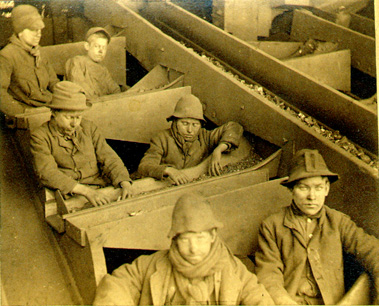Featured
- Get link
- X
- Other Apps
What is a Pickslate?
 |
| Breaker boys about 1884, about the same time Dominick worked as a pickslate.1 |
In researching my great, great grandparents Patrick and Ann McAndrew, I found they lived on Rockwell's Hill, in Scranton, Pennsylvania with their children in 1880. I was surprised to find that one son, my great, great uncle Dominick McAndrew, age 11, was employed at that young age as a "pickslate."2 What was a pickslate?
Picking slate was a boy's entry into the coal mines, the first job he might have. Young boys were sent to the local breaker to pick the impurities from the coal so that it could be graded and sold. They were also known as breaker boys.
In this dangerous work the boys often suffered cuts, bruises, and abrasions. At the worst, they could be caught in the conveyor belts that brought the coal up from the mine, and lose limbs or even their lives. They spent long hours stooped over their work, inhaling coal dust, which as it hovered in the air also made it difficult to see. They likely returned home filthy and exhausted with little time to rest and recuperate before they had to rise to do it again the next morning.
At the time there may have been good reason for Dominick to be working in the mines. His father Patrick was 42 years old and an outside laborer. Dominick was the eldest son and with six siblings ranging in age from 13 to 2, there were in total nine mouths to feed.3 Perhaps Patrick required Dominick to work, but it's also possible that he wanted to emulate his father and help provide for his family. Beginning as a pickslate Dominick had his "foot in the door" at the mine, and may have had the opportunity to work his way up through the ranks from a pickslate to a door boy, a mule boss, or even eventually a miner.
 |
| Evidence of a breaker boy's difficult life is shown in this 1911 photograph taken in Pittston, a short distance from Scranton. My Gilbride ancestors mined in Pittston in the 19th century.4 |
I wonder how long Dominick worked as a pickslate, or if he moved up the ranks in the local mines. Did the working conditions affect his lungs or his eyesight? Did he escape the mines and find a better occupation?
A man named Edward T. Morgan captured the hopes and dreams of a pickslate in a poem he wrote in 1870 and published in The Shendandoah Herald.
How varied are the sons of men,
How different are their fates,
Some live in comforts all along,
While I am picking slate.
It grieves me to the heart to think
The changes taking place,
For since my father lost his life,
Want stares me in the face.
I am not lazy, not at all
The work I do not hate,
But poverty surrounds me since
I started picking slate.
My compensation is but small
For working in such dust,
But mother taught me long ago
To say in “God we trust,”
Whatever is in store for me,
However so hard my fate,
I know I’ll be a man someday
And not be picking slate.
Today, it is unthinkable that an eleven-year-old would be sent out to work. It's sobering to reflect on the necessity of children like Dominick laboring in times past.
Until next time...
NOTES
1 George Bretz, "Breaker boys, Eagle Hill colliery, eastern PA," about 1884; image, Wikimedia Commons (https://commons.wikimedia.org/wiki/File:Breaker_boys,_Eagle_Hill_colliery,_eastern_PA_1.jpg : 23 March 2023). This work is in the public domain in its country of origin and other countries and areas where the copyright term is the author's life plus 70 years or fewer.
2 1880 U.S. Federal Census, Lackawanna County, Pennsylvania, population schedule, ED 55, p.30 (penned), dwelling 223, family 236, Patrick McAndraw household; database and images, Ancestry (https://www.ancestry.com/imageviewer/collections/6742/images/4244365-00740 : 23 March 2023); citing NARA microfilm publication T9, roll 1138.
3 Ibid.
4 Lewis Hine, "Group of Breaker boys," 1911; image, Wikimedia Commons
(https://commons.wikimedia.org/wiki/File:Group_of_Breaker_boys._Smallest_is_Sam_Belloma.jpg
: 23 March 2023); citing National Child Labor Committee collection at the Library of Congress. This work is in the public domain.
5 Stu Richards, "For all the Slate Pickers and Breaker Boys in the Anthracite Region," Coal Region History Chronicles, 9 March 2009 (http://coalregionhistorychronicles.blogspot.com : 23 March 2023), quoting Edward T. Morgan, "Song of the Slate Picker," 1870, The Shenandoah Herald, 28 July 1870. The poem is in the public domain.
Comments
The mining industry is not one I have encountered in my own research and I had never previously heard the term "pickslate." Thank you for the explanation! Have you been able to find Dominick in future census records to see if he continued to work in the mines or he made his way to a different profession?
ReplyDeleteYes, I did actually look briefly, and he did work in the mines later as well. I need to follow him further. I have a lot of mining ancestors on both ends of Pennsylvania. Some in the eastern side near Scranton, and my Eastern European maternal ancestors in the southeastern area near Pittsburgh.
DeleteWhat a heart wrenching story of child labor! And, unfortunately, violations of child labor laws are again creeping back in fast food chains. I also wonder about the health effects of being in the mines or any industrial occupation so young. Thanks for this post.
ReplyDelete